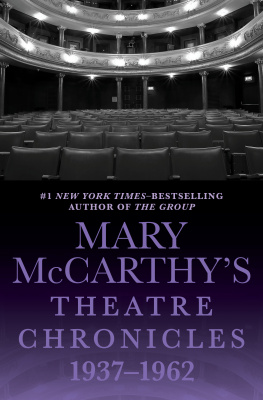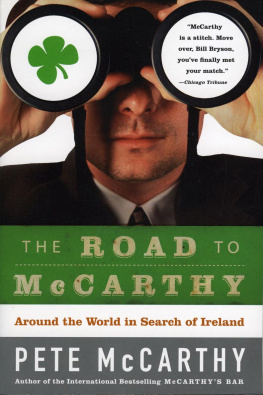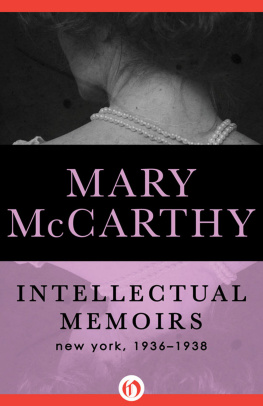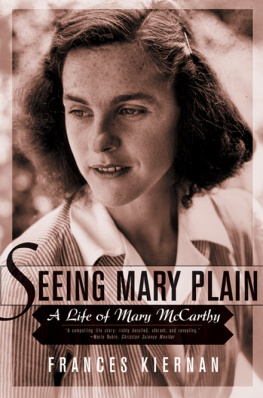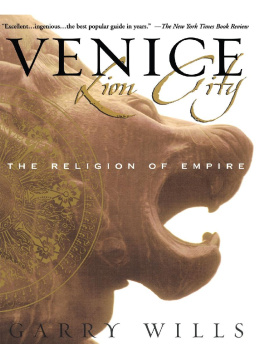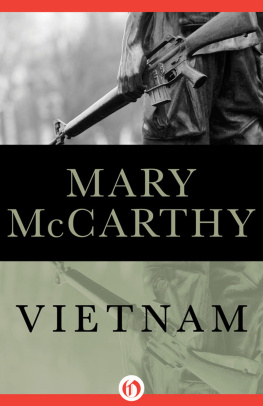

Venice Observed
Mary McCarthy

1
Venice Preserved
Venice at 8 to 9; went to Daniellis [sic]. Saw St Marks, the Piazza, the Grand Canal and some churches: fine dayvery picturesquegeneral effect fineindividual things not. Herbert Spencer in his diary, 1880.
Il disoit lavoir trouve autre quil ne lavoit imagine, et un peu moins admirable ... La police, la situation, larsenal, la place de S. Marc, et la presse des peuples trangiers lui semblarent les choses plus remerquables. Michel de Montaigne in his Journal du Voyage en Italie, 158081.
THE RATIONALIST MIND HAS always had its doubts about Venice. The watery city receives a dry inspection, as though it were a myth for the credulouspoets and honeymooners. Montaigne, his servant recorded, ny trouva pas cete fameuse beaut quon attribue aus dames de Venise, et si vid les plus nobles de celles qui en font traffique. That famous beautythe Frenchman sceptically sought it among the vaunted courtesans, who numbered 11,654 at the time of his visit. He had supper with the pearl of them all, no. 204 in the Catalogue of the Chief and Most Honoured Courtesans of Venice. Le lundi souper, 6 de novembre, la Signora Veronica Franco, janti fame venitiane, envoia vers lui pour lui presenter un petit livre de Lettres quelle a compos. It was evidently a literary evening. This Aspasia, at thirty-four, was retired from her profession and kept a salon frequented by poets and painters; she composed sonnets and letters and terza rima verses and had it in mind to write an epic poem. Henry III had visited her and brought back a report of her to France, together with two of her sonnets. But Montaigne was more impressed by the police and the high cost of living. Les vivres y sont chers come Paris
That famous beautythree hundred years later, the British philosopher, a bachelor, cocked a dubious eye at it in the touted palazzi. Everywhere he detected a striving for the picturesque. He was particularly unimpressed by the leading examples: the little, leaning Palazzo Dario, in the Lombard style, with insets of porphyry and verd-antique, the Corner Spinelli, by Mauro Coducci, with its remarkable balconies, and the Ca Rezzonico, the baroque grey-columned prodigy begun by Longhena, in which the poet Browning was shortly to die. The Doges Palace exasperated Spencer to the point where he felt it necessary to hint bluntly at some general principles of architecture: Dumpy arches of the lower tier of the Ducal Palace and the dumpy windows in the wall above ... the meaningless diaper pattern covering this wall, which suggests something woven rather than built; and the long row of projections and spikes surmounting the coping, which remind one of nothing so much as the vertebral spines of a fish. So much for the Doges Palace. And what about St Marks? Well, I admit that it is a fine sample of barbaric architecture.
Among Venices spells is one of peculiar potency: the power to awaken the philistine dozing in the sceptics breast. People of this kinddry, prose people of superior intelligenceobject to feeling what they are supposed to feel, in the presence of marvels. They wish to feel something else. The extreme of this position is to feel nothing. Such a case was Stendhals; Venice left him cold. He was there only a short time and departed with barely a comment to pursue an intrigue in Padua. Another lover of Italy, D. H. Lawrence (on one side of his nature, a debunker, a plain home-truth teller like Ruskin before him), put down his first reaction in a poem: Abhorrent green, slippery city, Whose Doges were old and had ancient eyes ... And Gibbon was afforded some hours of astonishment and some days of disgust by the spectacle of Venice.
This grossly advertised wonder, this gold idol with clay feet, this trompe-loeil, this painted deception, this clichwhat intelligent iconoclast could fail to experience a destructive impulse in her presence? Ruskin, who was her overdue Jeremiah, and who came in the end to detest nearly everything in Venice, spent half his days trying to expose her fraudsclimbing ladders in dusty churches to prove (what he had long suspected) that the Venetian Renaissance was a false front, a cynical trick, that the sleeping Doge Vendramin, for example, in marble effigy, atop his tomb in SS. Giovanni and Paolo was only a carven profile turned to the public: the other side, the side turned away from the public, being a vacancy, a featureless slab. Napoleon, Stendhals hero, went the whole way in brutal forthrightness, when he announced to the Venetian envoys, sent to treat diplomatically, his intention of shattering the image: I have 80,000 men and twenty gunboats; io non voglio pi Inquisitori, non voglio pi Senato; sar un Attila per lo stato Veneto.
Io non voglioa rude form of the verb, to wish. The phrase rings out, brazen, prophesying pillage: the sack of St Marks treasury, the rape of pictures for the Louvre, the agate-eyed, winged lion wrenched from his column on the quay to be carted off to the Invalides, the bronze horses of Nero hauled down from St Marks balcony to wait in front of the Tuileries until they could grace an arch of triumph on the Place du Carrousel.
The lion, damaged, came back. The horses came back. Their rape and return form simply another anecdote in the repertory of the guides of Venice, who drone it out in French, English and German, each to his flock of tourists herded in the Piazza between the three standards, where, on the eve of Napoleons appearance, the Tree of Liberty stood and a woman friend of Byrons, the Countess Querini-Benzoni, la biondina in gondoleta, danced round it, dressed only in an Athenian tunic.
Napoleons prophecy came true, though not altogether in the sense he meant. He did become another Attila for Venice, that is, a figure in its touristic legend, another discountenanced invader, like the Genoese at Chioggia, like Pepin, whose army was engulfed in the lagoons and perished, according to tradition, as the Egyptians did in the Red Sea. Attila opened the story; refugees, fleeing from him on the mainland, sought safety on the fishing islets and began to build their improbable city, houses of wattles and twigs set on piles driven into the mud, like sea-birds nests, wrote Cassiodorus, secretary of Theodoric, half on sea and half on land and spread like the Cyclades over the surface of the waters. Napoleon closed the story, as he closed in the Piazza San Marco with the Fabbrica Nuova at the end, giving themboth square and narrativetheir final, necessary form.
Without Napoleon, Venice would not be complete. Without Napoleon, the last Doge, Lodovico Manin (looking very much like a despondent housemaid in his portrait in the Museo Correr), could not have handed the ducal corno, tearfully, to a servant, saying, I wont be needing this any more. A pithy statement, in the matter-of-fact tradition of the noble Romans, from whom the Venetians claimed descent. And on the plebeian level, thanks to Napoleon, a gondolier had the last laugh. Examining Napoleons proclamation, which showed the armorial lion holding the Book, in which the old inscription,



